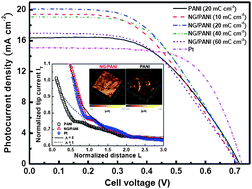Nanographite/polyaniline composite films as the counter electrodes for dye-sensitized solar cells†
Abstract
Nanographite/polyaniline (NG/PANI) composite films were developed and characterized, and the performances of the

* Corresponding authors
a Department of Chemical Engineering, National Taiwan University, Taipei, Taiwan
b Research Center for Applied Sciences, Academia Sinica, Taipei, Taiwan
c
Institute of Polymer Science and Engineering, National Taiwan University, Taipei, Taiwan
E-mail:
kcho@ntu.edu.tw
Fax: +886-2-2362-3040
Tel: +886-2-2366-0739
d Department of Photonics, National Chiao Tung University, Hsinchu, Taiwan
e Institute of Chemistry, Academia Sinica, Taipei, Taiwan
f
Department of Chemical and Materials Engineering, Tamkang University, Tamsui Dist., New Taipei City, Taiwan
E-mail:
cllin@mail.tku.edu.tw
Fax: +886-2-2620-9887
Tel: +886-2-2621-5656 ext. 2723
Nanographite/polyaniline (NG/PANI) composite films were developed and characterized, and the performances of the

 Please wait while we load your content...
Something went wrong. Try again?
Please wait while we load your content...
Something went wrong. Try again?
K. Huang, J. Huang, C. Wu, C. Liu, H. Chen, C. Chu, J. Lin, C. Lin and K. Ho, J. Mater. Chem., 2011, 21, 10384 DOI: 10.1039/C1JM10576K
To request permission to reproduce material from this article, please go to the Copyright Clearance Center request page.
If you are an author contributing to an RSC publication, you do not need to request permission provided correct acknowledgement is given.
If you are the author of this article, you do not need to request permission to reproduce figures and diagrams provided correct acknowledgement is given. If you want to reproduce the whole article in a third-party publication (excluding your thesis/dissertation for which permission is not required) please go to the Copyright Clearance Center request page.
Read more about how to correctly acknowledge RSC content.
 Fetching data from CrossRef.
Fetching data from CrossRef.
This may take some time to load.
Loading related content
